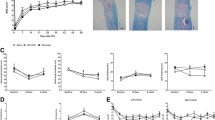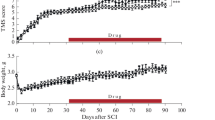Abstract
Following contusive spinal cord injury (SCI), calpain activity is dramatically increased and remains elevated for days to weeks. Although calpain inhibition has previously been demonstrated to be neuroprotective following spinal cord injury, most studies administered the calpain inhibitor at a single time point. We hypothesized that sustained calpain inhibition would improve functional and pathological outcomes, as compared to the results obtained with a single postinjury administration of the calpain inhibitor. Contusion SCI was produced in female Long-Evans rats using the Infinite Horizon spinal cord injury impactor at the 200 kdyn force setting. Open-field locomotor function was evaluated until 6 weeks postinjury. Histological assessment of lesion volume and tissue sparing was performed at 6 weeks after SCI. Calpain inhibitor MDL28170 administered as a single postinjury i.v. bolus (20 mg/kg) or as a daily i.p. dose (1 mg/kg) improved locomotor function, but did not increase tissue sparing. Combined i.v. and daily i.p. MDL28170 administration resulted in significant improvement in both functional and pathological outcome measures, supporting the calpain theory of SCI proposed by Dr. Banik and colleagues.






Similar content being viewed by others
References
Happel RD, Smith KP, Banik NL, Powers JM, Hogan EL, Balentine JD (1981) Ca2+-accumulation in experimental spinal cord trauma. Brain Res 211:476–479
Banik NL, Hogan EL, Powers JM, Whetstine LJ (1982) Degradation of cytoskeletal proteins in experimental spinal cord injury. Neurochem Res 7:1465–1475
Banik NL, Powers JM, Hogan EL (1980) The effects of spinal cord trauma on myelin. J Neuropathol Exp Neurol 39:232–244
Banik NL, Hogan EL, Powers JM, Smith KP (1986) Proteolytic enzymes in experimental spinal cord injury. J Neurol Sci 73:245–256
Banik NL, Hogan EL, McAlhaney WW (1984) A role for calcium and activation of neutral proteinase in myelinolysis? Prog Clin Biol Res 146:145–152
Banik NL, Shields DC, Ray S, Davis B, Matzelle D, Wilford G, Hogan EL (1998) Role of calpain in spinal cord injury: effects of calpain and free radical inhibitors. Ann N Y Acad Sci 844:131–137
Ray SK, Wilford GG, Matzelle DC, Hogan EL, Banik NL (1999) Calpeptin and methylprednisolone inhibit apoptosis in rat spinal cord injury. Ann N Y Acad Sci 890:261–269
Zhang SX, Bondada V, Geddes JW (2003) Evaluation of conditions for calpain inhibition in the rat spinal cord: effective postinjury inhibition with intraspinal MDL28170 microinjection. J Neurotrauma 20:59–67
Wang KK (1990) Developing selective inhibitors of calpain. Trends Pharmacol Sci 11:139–142
Wang KK, Yuen PW (1997) Development and therapeutic potential of calpain inhibitors. Adv Pharmacol 37:117–152
Ray SK, Matzelle DD, Sribnick EA, Guyton MK, Wingrave JM, Banik NL (2003) Calpain inhibitor prevented apoptosis and maintained transcription of proteolipid protein and myelin basic protein genes in rat spinal cord injury. J Chem Neuroanat 26:119–124
Schumacher PA, Siman RG, Fehlings MG (2000) Pretreatment with calpain inhibitor CEP-4143 inhibits calpain I activation and cytoskeletal degradation, improves neurological function, and enhances axonal survival after traumatic spinal cord injury. J Neurochem 74:1646–1655
Markgraf CG, Velayo NL, Johnson MP, McCarty DR, Medhi S, Koehl JR, Chmielewski PA, Linnik MD (1998) Six-hour window of opportunity for calpain inhibition in focal cerebral ischemia in rats. Stroke 29:152–158
Banik NL, Matzelle DC, Gantt-Wilford G, Osborne A, Hogan EL (1997) Increased calpain content and progressive degradation of neurofilament protein in spinal cord injury. Brain Res 752:301–306
Springer JE, Azbill RD, Kennedy SE, George J, Geddes JW (1997) Rapid calpain I activation and cytoskeletal protein degradation following traumatic spinal cord injury: attenuation with riluzole pretreatment. J Neurochem 69:1592–1600
Zhang SX, Underwood M, Landfield A, Huang FF, Gison S, Geddes JW (2000) Cytoskeletal disruption following contusion injury to the rat spinal cord. J Neuropathol Exp Neurol 59:287–296
Arataki S, Tomizawa K, Moriwaki A, Nishida K, Matsushita M, Ozaki T, Kunisada T, Yoshida A, Inoue H, Matsui H (2005) Calpain inhibitors prevent neuronal cell death and ameliorate motor disturbances after compression-induced spinal cord injury in rats. J Neurotrauma 22:398–406
Scheff SW, Rabchevsky AG, Fugaccia I, Main JA, Lumpp JE Jr (2003) Experimental modeling of spinal cord injury: characterization of a force-defined injury device. J Neurotrauma 20:179–193
Basso DM, Beattie MS, Bresnahan JC (1996) Graded histological and locomotor outcomes after spinal cord contusion using the NYU weight-drop device versus transection. Exp Neurol 139:244–256
Yu CG, Marcillo AE, Fairbanks CA, Wilcox GL, Yezierski RP (2000) Agmatine improves locomotor function and reduces tissue damage following spinal cord injury. Neuroreport 11:3203–3207
Rabchevsky AG, Fugaccia I, Sullivan PG, Scheff SW (2001) Cyclosporin A treatment following spinal cord injury to the rat: behavioral effects and stereological assessment of tissue sparing. J Neurotrauma 18:513–522
Ray SK, Shields DC, Saido TC, Matzelle DC, Wilford GG, Hogan EL, Banik NL (1999) Calpain activity and translational expression increased in spinal cord injury. Brain Res 816:375–380
Schumacher PA, Eubanks JH, Fehlings MG (1999) Increased calpain I-mediated proteolysis, and preferential loss of dephosphorylated NF200, following traumatic spinal cord injury. Neuroscience 91:733–744
Das A, Sribnick EA, Wingrave JM, Del Re AM, Woodward JJ, Appel SH, Banik NL, Ray SK (2005) Calpain activation in apoptosis of ventral spinal cord 4.1 (VSC4.1) motoneurons exposed to glutamate: calpain inhibition provides functional neuroprotection. J Neurosci Res 81:551–562
Momeni HR, Kanje M (2005) The calpain inhibitor VI prevents apoptosis of adult motor neurons. Neuroreport 16:1065–1068
O’Hanlon GM, Humphreys PD, Goldman RS, Halstead SK, Bullens RW, Plomp JJ, Ushkaryov Y, Willison HJ (2003) Calpain inhibitors protect against axonal degeneration in a model of anti-ganglioside antibody-mediated motor nerve terminal injury. Brain 126:2497–2509
James T, Matzelle D, Bartus R, Hogan EL, Banik NL (1998) New inhibitors of calpain prevent degradation of cytoskeletal and myelin proteins in spinal cord in vitro. J Neurosci Res 51:218–222
Shields DC, Schaecher KE, Hogan EL, Banik NL (2000) Calpain activity and expression increased in activated glial and inflammatory cells in penumbra of spinal cord injury lesion. J Neurosci Res 61:146–150
Schaecher KE, Shields DC, Banik NL (2001) Mechanism of myelin breakdown in experimental demyelination: a putative role for calpain. Neurochem Res 26:731–737
Ray SK, Neuberger TJ, Deadwyler G, Wilford G, DeVries GH, Banik NL (2002) Calpain and calpastatin expression in primary oligodendrocyte culture: preferential localization of membrane calpain in cell processes. J Neurosci Res 70:561–569
Watanabe N, Kobayashi Y (1994) Selective release of a processed form of interleukin 1 alpha. Cytokine 6:597–601
Schaub FJ, Liles WC, Ferri N, Sayson K, Seifert RA, Bowen-Pope DF (2003) Fas and Fas-associated death domain protein regulate monocyte chemoattractant protein-1 expression by human smooth muscle cells through caspase- and calpain-dependent release of interleukin-1alpha. Circ Res 93:515–522
Pianetti S, Arsura M, Romieu-Mourez R, Coffey RJ, Sonenshein GE (2001) Her-2/neu overexpression induces NF-kappaB via a PI3-kinase/Akt pathway involving calpain-mediated degradation of IkappaB-alpha that can be inhibited by the tumor suppressor PTEN. Oncogene 20:1287–1299
Stewart MP, McDowall A, Hogg N (1998) LFA-1-mediated adhesion is regulated by cytoskeletal restraint and by a Ca2+-dependent protease, calpain. J Cell Biol 140:699–707
Rock MT, Dix AR, Brooks WH, Roszman TL (2000) Beta1 integrin-mediated T cell adhesion and cell spreading are regulated by calpain. Exp Cell Res 261:260–270
Cuzzocrea S, McDonald MC, Mazzon E, Siriwardena D, Serraino I, Dugo L, Britti D, Mazzullo G, Caputi AP, Thiemermann C (2000) Calpain inhibitor I reduces the development of acute and chronic inflammation. Am J Pathol 157:2065–2079
Ray SK, Hogan EL, Banik NL (2003) Calpain in the pathophysiology of spinal cord injury: neuroprotection with calpain inhibitors. Brain Res Brain Res Rev 42:169–185
Ray SK, Matzelle DC, Wilford GG, Hogan EL, Banik NL (2000) E-64-d prevents both calpain upregulation and apoptosis in the lesion and penumbra following spinal cord injury in rats. Brain Res 867:80–89
Hung KS, Hwang SL, Liang CL, Chen YJ, Lee TH, Liu JK, Howng SL, Wang CH (2005) Calpain inhibitor inhibits p35-p25-Cdk5 activation, decreases tau hyperphosphorylation, and improves neurological function after spinal cord hemisection in rats. J Neuropathol Exp Neurol 64:15–26
Mehdi S (1991) Cell-penetrating inhibitors of calpain. Trends Biochem Sci 16:150–153
Saatman KE, Zhang C, Bartus RT, McIntosh TK (2000) Behavioral efficacy of posttraumatic calpain inhibition is not accompanied by reduced spectrin proteolysis, cortical lesion, or apoptosis. J Cereb Blood Flow Metab 20:66–73
Kupina NC, Nath R, Bernath EE, Inoue J, Mitsuyoshi A, Yuen PW, Wang KK, Hall ED (2001) The novel calpain inhibitor SJA6017 improves functional outcome after delayed administration in a mouse model of diffuse brain injury. J Neurotrauma 18:1229–1240
Magnuson DS, Trinder TC, Zhang YP, Burke D, Morassutti DJ, Shields CB (1999) Comparing deficits following excitotoxic and contusion injuries in the thoracic and lumbar spinal cord of the adult rat. Exp Neurol 156:191–204
Teng YD, Wrathall JR (1997) Local blockade of sodium channels by tetrodotoxin ameliorates tissue loss and long-term functional deficits resulting from experimental spinal cord injury. J Neurosci 17:4359–4366
Blight AR (1983) Cellular morphology of chronic spinal cord injury in the cat: analysis of myelinated axons by line-sampling. Neuroscience 10:521–543
Liu X, Van Vleet T, Schnellmann RG (2004) The role of calpain in oncotic cell death. Annu Rev Pharmacol Toxicol 44:349–370
Brorson JR, Marcuccilli CJ, Miller RJ (1995) Delayed antagonism of calpain reduces excitotoxicity in cultured neurons. Stroke 26:1259–1266, discussion 1267
Bano D, Young KW, Guerin CJ, Lefeuvre R, Rothwell NJ, Naldini L, Rizzuto R, Carafoli E, Nicotera P (2005) Cleavage of the plasma membrane Na+/Ca2+ exchanger in excitotoxicity. Cell 120:275–285
Kieran D, Greensmith L (2004) Inhibition of calpains, by treatment with leupeptin, improves motoneuron survival and muscle function in models of motoneuron degeneration. Neuroscience 125:427–439
Moore JD, Rothwell NJ, Gibson RM (2002) Involvement of caspases and calpains in cerebrocortical neuronal cell death is stimulus-dependent. Br J Pharmacol 135:1069–1077
Volbracht C, Chua BT, Ng CP, Bahr BA, Hong W, Li P (2005) The critical role of calpain versus caspase activation in excitotoxic injury induced by nitric oxide. J Neurochem 93:1280–1292
Crocker SJ, Smith PD, Jackson-Lewis V, Lamba WR, Hayley SP, Grimm E, Callaghan SM, Slack RS, Melloni E, Przedborski S, Robertson GS, Anisman H, Merali Z, Park DS (2003) Inhibition of calpains prevents neuronal and behavioral deficits in an MPTP mouse model of Parkinson’s disease. J Neurosci 23:4081–4091
Acknowledgements
This research was supported by NIH RO1 NS 045726 and by the Kentucky Spinal Cord and Head Injury Research Trust.
Author information
Authors and Affiliations
Corresponding author
Additional information
Special issue in honor of Naren Banik.
Rights and permissions
About this article
Cite this article
Yu, CG., Geddes, J.W. Sustained Calpain Inhibition Improves Locomotor Function and Tissue Sparing Following Contusive Spinal Cord Injury. Neurochem Res 32, 2046–2053 (2007). https://doi.org/10.1007/s11064-007-9347-4
Received:
Accepted:
Published:
Issue Date:
DOI: https://doi.org/10.1007/s11064-007-9347-4




